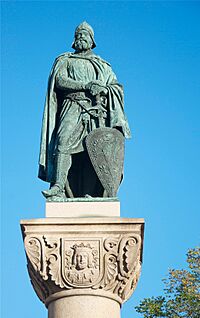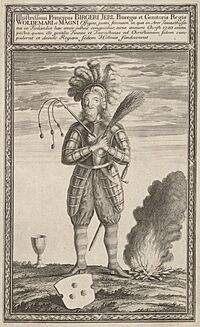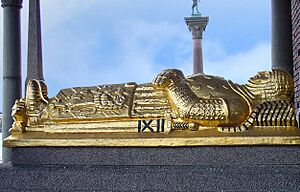Birger Jarl facts for kids
Quick facts for kids
Birger Jarl
|
|
|---|---|

Birger in Varnhem Church
|
|
| Jarl of Sweden | |
| Tenure | c. 1248 – 1266 |
| Monarch | |
| Predecessor | Ulf Fase |
| Born | c. 1210 probably in Östergötland |
| Died | 21 October 1266 (aged 55–56) Jälbolung, Västergötland |
| Buried | Varnhem Abbey, Västergötland |
| Spouse(s) |
|
| Issue |
|
| Parents |
|
Birger Jarl (around 1210 – 21 October 1266), also known as Birger Magnusson, was a very important Swedish leader. He was a regent (someone who rules for a king who is too young or unable to rule) and a jarl, which was a high-ranking noble title. Birger was part of the House of Bjelbo, a powerful family in Sweden. He played a huge role in making Sweden a stronger, more united country.
Birger's first marriage was to Princess Ingeborg of Sweden. This marriage helped him gain a lot of power. He led the Second Swedish Crusade, which helped establish Swedish rule in Finland. People also believe he founded Stockholm, the capital city of Sweden, around the year 1250. Birger used the Latin title Dux Sweorum, meaning "Duke of Sweden."
Contents
Birger Jarl: A Powerful Leader
Early Life and Family
Birger grew up in a place called Bjälbo in Östergötland, Sweden. We don't know his exact birth date, but he was likely born around 1210. His mother was Ingrid Ylva, and his father was Magnus Minnesköld. Birger was also the nephew of another powerful jarl named Birger Brosa. This family background was very important for his future.
In the mid-1230s, Birger married Ingeborg Eriksdotter, who was the sister of King Eric XI of Sweden. This marriage helped him become even more influential in Sweden.
Rising to Power
Over the next 15 years, Birger became one of the most powerful men in Sweden. In 1248, King Eric XI officially gave him the title of jarl. Birger was the last person to hold this important title in Sweden. Some historians even call him the "first true king of Sweden" because of how much power he had.
Around 1248, a special visitor from the Pope, William of Modena, came to Sweden. He encouraged the Swedish leaders to follow the rules of the Catholic Church. Birger used this opportunity to side with the Church, which made him even stronger. This helped create a more united Swedish kingdom, supported by the Pope.

In 1247, Birger led royal troops in the Battle of Sparrsätra. They fought against a group called the Folkung forces. Birger's side won, which helped the central government gain more control. The Folkung leader, Holmger Knutsson, was captured and later executed.
In 1249, Birger helped end a long period of fighting with Norway. As part of a peace agreement called the Treaty of Lödöse, his daughter Rikissa, who was only 11, married the son of the Norwegian king.
Later that year, Birger led an expedition to Finland. This event is known as the Second Swedish Crusade. It led to Sweden permanently ruling Finland.
When King Eric XI died in 1250, Birger's son Valdemar was chosen as the new king. However, Birger acted as the true ruler, or regent, of Sweden until he died.
Founding Stockholm
In 1252, Birger wrote two important letters. These letters are the first time Stockholm is mentioned, and many believe this marks the founding of the city. Stockholm was likely chosen for several reasons:
- It could protect the lands around Lake Mälaren from enemies.
- It was a good place to attract German merchants and boost trade.
While we don't know exactly how much Birger was involved in building the city, it was definitely founded at an important time. It helped Sweden move from older military traditions to more modern trade efforts. Birger used financial support from Germany and political support from the Pope to make his own position stronger.
Later Life and Legacy
Birger's first wife, Ingeborg, died in 1254. In 1261, he married Matilda of Holstein, who was the queen dowager of Denmark. Birger Jarl died on October 21, 1266, in Västergötland. His grave at Varnhem Abbey was opened in 2002 for study.
Today, there are many things named after Birger Jarl in Stockholm. There is a statue of him in Birger Jarls Torg (Birger Jarl's Square) near Riddarholm Church. There's also a special monument for him at the Stockholm City Hall. Other places include the street Birger Jarlsgatan and the tower Birger Jarls Torn. The Hotel Birger Jarl in Stockholm is also named after him.
Birger Jarl's Children
Birger Jarl had several children.
From his marriage with Ingeborg Eriksdotter of Sweden
- Rikissa Birgersdotter: Born in 1238. She married Haakon Haakonsson the Young, who was a co-king of Norway.
- Valdemar Birgersson: Born around 1238. He became king of Sweden in 1250.
- Christina Birgersdotter
- Magnus Birgersson: Born in 1240. He became Duke, then king of Sweden in 1275.
- Catherine of Sweden: Born in 1245.
- Eric Birgersson: Born in 1250. He was a Duke.
- Ingeborg of Sweden: Born around 1254.
- Benedict, Duke of Finland: Born in 1254. He became a bishop.
Mother unknown
- Gregers Birgersson
See also
 In Spanish: Birger Jarl para niños
In Spanish: Birger Jarl para niños
- List of monarchs and heads of state of Finland
- Ingeborg Eriksdotter of Sweden, Duchess of Sweden 1248–1254
- Matilda of Holstein, Duchess of Sweden 1261–1288





